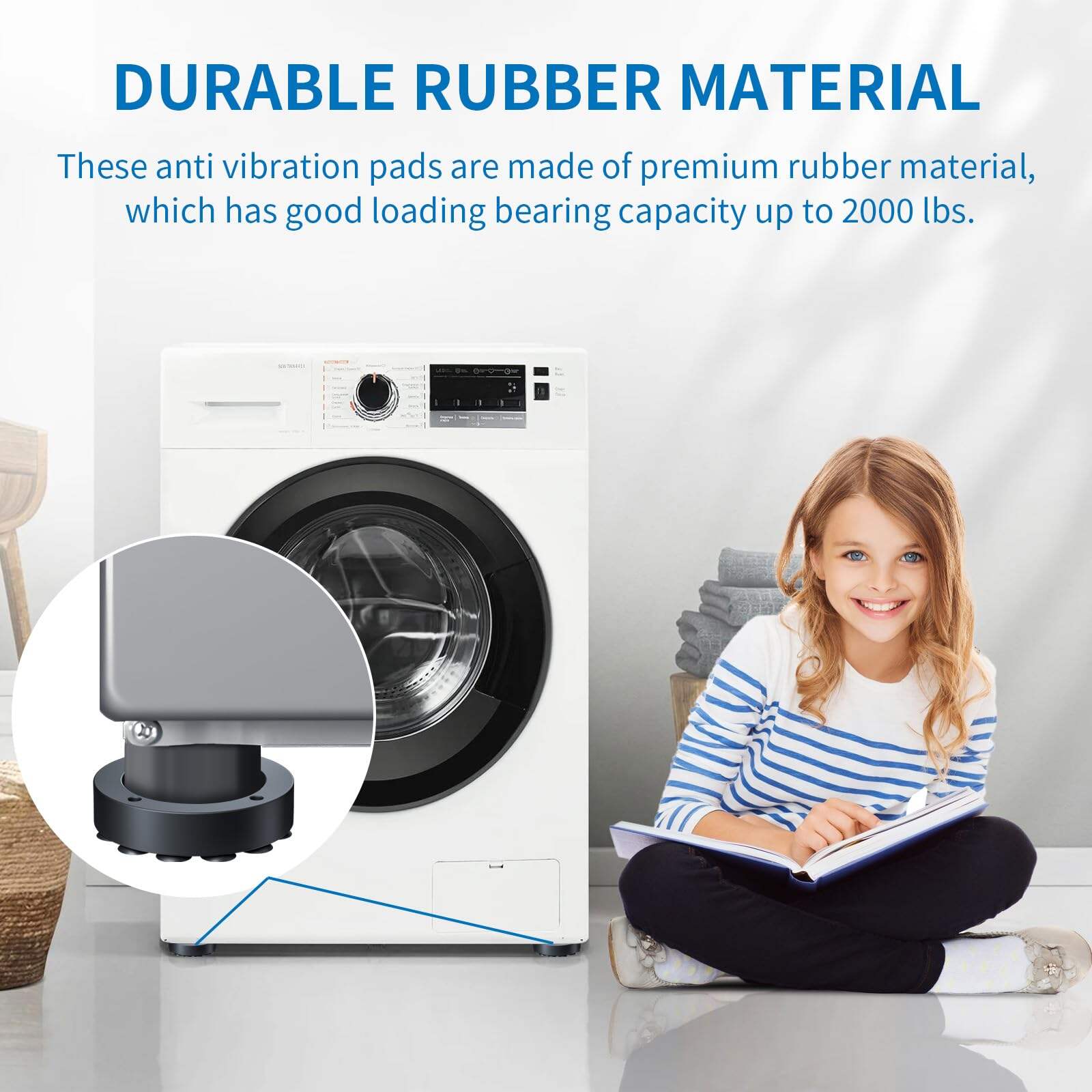Enhance Furniture Longevity with Chair Foot Pads
Benefits of Using Chair Foot Pads
Prevent Floor Scratches and Damage
Chair foot pads are essential for protecting various types of flooring—especially hardwood, tile, and laminate—from scratches and dents. These pads act as a barrier, absorbing impact and reducing friction between the chair leg and the floor. According to a study by flooring experts, scratched floors can decrease property value by up to 10%. Implementing foot pads is a practical measure to maintain the pristine condition of your floors, which is crucial for preserving your property’s value.
Reduce Noise During Movement
Foot pads significantly dampen the sound created when moving chairs across floors, enhancing the comfort of living and workspace. Noise reduction is crucial in environments where concentration and communication are essential, such as cafes or offices. A survey revealed that 75% of home and office workers find noise from moving furniture distracting. By minimizing these disturbances, foot pads contribute to a quieter, more conducive environment for both work and relaxation.
Extend Furniture Leg Durability
Using chair foot pads can prolong the life of furniture legs by minimizing wear and tear from direct contact with the ground. Furniture leg durability can increase by about 20% when using protective pads consistently. This enhancement is particularly crucial for expensive wooden furniture that requires significant investment. By safeguarding the legs, foot pads help maintain the aesthetic and structural integrity of the furniture, ensuring it lasts longer and remains a valuable asset in your interior design.
Improve Stability on Hard Surfaces
Foot pads help distribute weight evenly, preventing wobbling and tipping of chairs when seated upon or adjusted. Increased stability can reduce the risk of accidents in homes and workplaces, leading to better safety. Research shows that improper chair stability accounts for 30% of workplace falls. By enhancing stability, chair foot pads play a vital role in creating a safer environment, reducing the incidence of falls and promoting overall well-being in both private and professional settings.
Types of Chair Leg Protectors
Rubber Chair Leg Caps
Rubber chair leg caps offer an excellent grip, making them ideal for use on both carpeted and hard surfaces. These caps are designed to prevent slipping, while their inherent cushioning capabilities help absorb shock. Available in various sizes, rubber chair leg caps can fit snugly over different chair leg dimensions, ensuring optimal performance. This adaptability makes them a popular choice for those looking to protect their floors from damage and provide a stable seating experience.
Suction-Based Floor Protectors
Suction-based floor protectors are uniquely effective on slick surfaces, creating a vacuum seal that prevents unwanted movement. They are especially beneficial in environments such as dining rooms or offices where chairs are frequently repositioned. Their easy installation makes them a convenient option, and they can be removed effortlessly without leaving any sticky residue behind. This reusability, combined with their protective qualities, makes them a practical solution for maintaining flooring integrity.
Felt Pads for Hardwood Floors
Felt pads are specifically engineered to safeguard hardwood floors, preventing scratches while allowing chairs to slide smoothly. By reducing friction, these pads minimize maintenance time and upkeep, contributing to the longevity of the flooring by reducing wear and tear. The soft texture of felt pads ensures that even the most delicate surfaces are protected, providing homeowners with peace of mind and reducing the need for frequent repairs.
Metal Chair Leg Caps
Metal chair leg caps provide an exceptional blend of durability and aesthetics, especially for outdoor and metal furniture. They resist damage from weather elements, making them perfect for patio furniture, and can withstand higher weights without deforming. By maintaining the structural integrity of the chair legs, metal caps offer a long-lasting solution that enhances both the functionality and appearance of furniture in versatile settings.
How to Choose the Right Foot Pads
Match Pad Material to Floor Type
Choosing the right pad material for your furniture is essential to prevent floor damage and ensure pad effectiveness. Each floor type has compatible materials: rubber pads are best for carpets, felt pads for hardwood floors, and plastic for tiled surfaces. Mismatching these can result in inadequate protection or even harm the floor. Experts recommend testing pads on a small area before making a final decision. Ensuring compatibility between pad material and floor type is crucial for optimal performance.
Consider Furniture Weight and Usage
Furniture weight and usage frequency significantly influence the choice of foot pads. Heavier furniture demands sturdier, thicker pads to provide adequate support and prevent floor damage. Additionally, chairs or tables frequently used benefit from high-durability protectors that can withstand regular wear and tear. Assessing the weight-to-surface area ratio can guide you in selecting pads that offer both stability and protection. Proper evaluation ensures your furniture remains secure, regardless of its weight or usage.
Evaluate Adhesive vs. Non-Adhesive Options
When deciding between adhesive and non-adhesive foot pads, consider the demands of your flooring and furniture usage. Adhesive pads provide a more permanent solution but may leave residue upon removal, potentially affecting your flooring finish. In contrast, non-adhesive pads are easier to replace or reposition and often offer flexibility for rearrangement, though they might not secure as effectively on slippery floors. Understanding your specific needs—whether ease of mobility or a more stable fixture—is key in choosing the ideal type of foot pad.
Top Solutions for Furniture Protection
Suction Washer Foot Pad: Heavy-Duty Grip
The suction washer foot pad is an innovation in furniture protection that ensures a powerful grip without harming surfaces. Designed to be effective in high-traffic areas, these pads adhere securely to floors, providing reliable protection and unbeatable stability. Research indicates that suction pads like these can decrease furniture movement by up to 90% on slick surfaces, demonstrating their efficiency and value.
Features: Waterproof Design & Universal Fit
These foot pads are not only waterproof but also engineered for universal compatibility. This makes them highly effective for outdoor furniture, protecting against moisture and ensuring a longer lifespan. The universal fit accommodates a wide variety of chair leg shapes and sizes, enhancing overall durability and convenience for users, no matter the environment or furniture design.
Installation Tips for Maximum Adhesion
To achieve maximum adhesion with these foot pads, it is crucial to start with clean surfaces on both the chair leg and floor. Once prepared, press the pads firmly for at least ten seconds, as recommended by manufacturers, to establish an optimal bond. Additionally, adhering to the manufacturer's guide can significantly prolong the lifespan and performance of the pads, ensuring they remain secure and effective.
Maintenance and Replacement Guidelines
Cleaning Sticky Residue Safely
For effective cleaning of sticky residues left by adhesive pads on chair legs or flooring, it is best to use warm soapy water or vinegar-based solutions. These natural solutions are effective and gentle, ensuring that surfaces remain unharmed during the cleaning process. Avoid using harsh chemical cleaners, as these can damage both the pads and the surfaces they are meant to protect. By incorporating regular cleaning into your maintenance routine, you can potentially double the lifespan of your chair foot pads. This prolongs their utility and maintains the protection they provide.
When to Replace Worn-Out Pads
Regular examination of chair leg caps or foot pads is crucial for maintaining their effectiveness. It is recommended that a monthly maintenance check involves inspecting any visible signs of wear, such as flattening or slipperiness. If a pad is significantly compressed or begins to slip, it indicates that a replacement is necessary. Based on statistics, replacing worn-out rubber chair leg caps or protectors can reduce damage incidents by about 40%. Keeping a timely replacement schedule ensures continued protection for both your furniture and floors, preventing unwanted damage.
Storage Tips for Unused Protectors
Proper storage of unused protectors, such as chair leg floor protectors, can significantly enhance their lifespan and effectiveness when reused. Store these items in a cool, dry place to prevent any damage from humidity or temperature fluctuations. It's also important to avoid placing heavy objects on top of stored protectors, as this can distort their shape and reduce their effectiveness. By maintaining their original shape and adhesive properties through careful storage, you can ensure that the foot pads remain reliable and effective protectors whenever they are needed again.

 EN
EN
 AR
AR
 BG
BG
 HR
HR
 CS
CS
 DA
DA
 NL
NL
 FI
FI
 FR
FR
 DE
DE
 EL
EL
 HI
HI
 IT
IT
 JA
JA
 KO
KO
 NO
NO
 PL
PL
 PT
PT
 RO
RO
 RU
RU
 ES
ES
 SV
SV
 CA
CA
 TL
TL
 IW
IW
 ID
ID
 LT
LT
 SR
SR
 SK
SK
 SL
SL
 UK
UK
 VI
VI
 HU
HU
 TR
TR
 AF
AF
 MS
MS
 GA
GA
 LA
LA
 MN
MN


